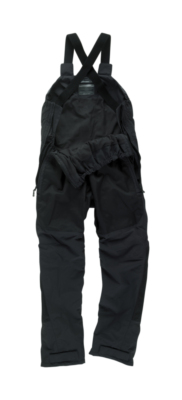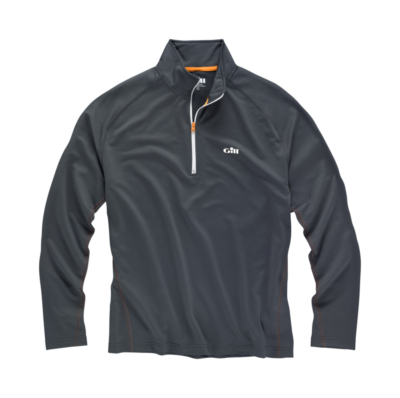Comfort and efficiency
Dressing according to the type of sailing
The jacket, because of its design, is more waterproof than the vest and, if it has an effective tightening system, such as a neoprene band, closes more firmly around the neck. The size must be chosen correctly and should also close with a band. Efficient yes, but less convenient to put on than a vest. The vest though, is more difficult to seal. It is necessary to use models that hold squarely at the collar, with hermetically sealed or double pockets. The seams must also be sealed and fitted with a flap closure.

Breathable three layered system
On a boat, we often undertake short intense periods of effort followed by periods of inaction. It is necessary therefore, that one is able to perspire during the effort and not remain damp the rest of the time, as this may engender a sensation of cold. The new materials permit perspiration to move toward the exterior and keep the body dry. This system, if followed to the letter, functions very well.
First layer
The layer closest to the body is composed of polyester under garments which drain the perspiration toward the exterior. Cotton T-shirts which soak up water are therefore forbidden. In fair weather this layer is sufficient.
Second layer
The second layer protects the body from the cold. It is composed of a fleece layer, the thickness of which is adapted to the conditions encountered. Attention, these polyester fleeces also work to expel water.
Do not choose a wool sweater to keep warm; you will be cold when it is full of water!
Third layer.
The third layer serves to protect against the elements (rain, spray, wind…) it acts as a wax layer. The clothing must be sealed from the exterior but let perspiration leave. These clothes are described as breathable.
First layer
The layer closest to the body is composed of polyester under garments which drain the perspiration toward the exterior. Cotton T-shirts which soak up water are therefore forbidden. In fair weather this layer is sufficient.
Second layer
The second layer protects the body from the cold. It is composed of a fleece layer, the thickness of which is adapted to the conditions encountered. Attention, these polyester fleeces also work to expel water.
Do not choose a wool sweater to keep warm; you will be cold when it is full of water!
Third layer.
The third layer serves to protect against the elements (rain, spray, wind…) it acts as a wax layer. The clothing must be sealed from the exterior but let perspiration leave. These clothes are described as breathable.

Coating or membrane?
The sweat molecule (vapour) is smaller than a water molecule. A breathable fabric has a grid, sufficiently fine, to permit sweat to leave (toward the exterior,) and prevent water returning. This grid is obtained by use of a coating or adding a membrane.
The coating is a kind of paint that is added to the interior of the clothing to render the sealing breathable. This system has the advantage of being less expensive but the drawback of being a little fragile, particularly within the folds (the coating may break off over time.) Coated clothes are better reserved for occasional usage (an annual cruise for example.)
The membrane is glued to the interior of the garment. Very fine, it is invisible. The membrane often carries a brand name, Gore-tex being perhaps the most well known. One may find it on the wax and also in the boots. More solid and impermeable it is also more expensive than coated clothing.
The coating is a kind of paint that is added to the interior of the clothing to render the sealing breathable. This system has the advantage of being less expensive but the drawback of being a little fragile, particularly within the folds (the coating may break off over time.) Coated clothes are better reserved for occasional usage (an annual cruise for example.)
The membrane is glued to the interior of the garment. Very fine, it is invisible. The membrane often carries a brand name, Gore-tex being perhaps the most well known. One may find it on the wax and also in the boots. More solid and impermeable it is also more expensive than coated clothing.
So sea clothing maintains all its qualities, it is advisable to wash it
regularly. In a machine, one must use specific products, which help
maintain water repellent characteristics and avoids clothes rapidly
becoming engorged with water during use. In effect, even if clothes are
sealed by a coating or membrane, the repellent product prevents the
exterior layer holding water.
regularly. In a machine, one must use specific products, which help
maintain water repellent characteristics and avoids clothes rapidly
becoming engorged with water during use. In effect, even if clothes are
sealed by a coating or membrane, the repellent product prevents the
exterior layer holding water.
Size equivalency table
|
|
XS |
S |
M |
L |
XL |
XXL |
XXXL |
|
Hauteur |
5'2"-5'4" |
5'4"-5''7" |
5''7"-5"10" |
5'10"-6'1" |
6'1"-6'2" |
6'2"-6'3" |
6'2"-6'3" |
|
(cm) |
158-163 |
163-170 |
170-178 |
178-186 |
186-188 |
188-191 |
188-191 |
|
UK |
8 |
10 |
12 |
14 |
16 |
18 |
20 |
|
USA |
4 |
6 |
8 |
10 |
12 |
14 |
16 |
|
EUROPE |
34 |
36 |
38 |
40 |
42 |
44 |
46 |
